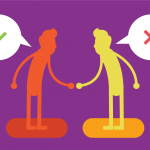
Studies have shown that children who engage in ‘arts and craft’ in their early years are more likely to have a healthier sense of self and overall comfort in their immediate surroundings (DEEWR, 2009). If the opportunity to be creative is provided in a guaranteed ‘judgement free’ environment, the place for abstract thoughts and production is boundless. In a time where innovation and creativity are so eagerly sought after, how can we replicate these opportunities in the workplace?
It doesn’t take a scientific study to make the observation that as we get older, in most cases, the flow of our ‘creative juices’ becomes noticeably weaker. The majority of us fall into a routine, with limited opportunity for ‘new’ experiences encouraging even fewer unique thoughts. Unless we make the effort to maintain our hobbies, we can receive little mental stimulation. Reduced to this stable routine, with the mindset that there is simply no time to fit in exciting extras, we become disillusioned with what life is offering and this mentality trickles its way throughout all aspects of our lives.
As most time in our day is spent in the workplace, this is where the effects of disillusionment can make the most noise. The Adobe ‘Global Benchmark Study on Attitudes and Beliefs about Creativity at Work, School and Home’ made claims that 75% of people reported feeling as though they are not utilising their full creative capabilities in their job (Adobe, 2012). Not surprisingly the same percentage responded that they feel under pressure to be productive rather than creative at work (Adobe, 2012). A person that heads to work every morning to watch the clock tick around to 5’clock is a worker that has lost both their sense of purpose and their contribution to the greater goals of the organisation. Feeling lost and of little value to the organisation can significantly stunt an individual’s productivity; they can no longer see the value that their work adds to the overall organisational effectiveness, resulting in a loss of motivation.
Not only can creativity serve as a factor of motivation for the individual, it has also been identified as a crucial element of an organisation’s progress. Research published in the Annual Review of Organisational Psychology and Organisational Behaviour states that “workplace creativity exhibited by individual employees and teams is a key driver of organizational innovation and success” (Zhou & Hoever, 2014).
The question then presents itself: how do you encourage creativity from employees in the workplace in roles that are not inherently creative?
Before you reach for the finger-painting kit, consider this – the opportunity to see processes and problems in new ways and produce new solutions is the opportunity for creative and innovative thinking. So, are there communication channels in place for the open discussion of new ideas? Is your organisation willing to consider new methods of production? Not every idea has to be implemented, however a system that operates as it always has will only ever achieve what it always does.
Establishing this ‘suggestion box’ of sorts – a direct line of communication between employees and management – allows the option for thoughts and ideas to be heard. To be heard is to be valued. There are few things that motivate an individual more than knowing their contributions are both noticed and appreciated. By no means does every idea need to be implemented, simply considered. If there is a reason things are the way they are, this should be explained, circulating higher understanding and reason behind particular processes.
Creativity in the workplace should be like the ‘arts and craft’ time of our adulthood: encouraged, judgement free, and a collaborative process. Perhaps this will grant more of us a greater sense of purpose and belonging in our grown-up playgrounds.
References:
Adobe. (2012). STATE OF CREATE STUDY Global Benchmark Study on Attitudes and Beliefs about Creativity at Work, School and Home.
Department of Education, Employment and Workplace Relations [DEEWR]. (2009). BEING, BELONGING & BECOMING The Early Years Learning Framework for Australia. Canberra: DEEWR Publishing






